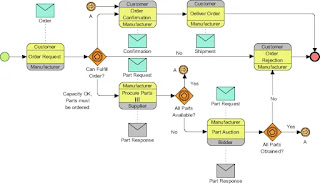HERY PURNAMA, SE.,MM.
MCP, PMP, CISM, CISSP, CISA, ITILF, CTFL, CDMP
SILABUS TRAINING
BUSINESS PROCESS MODEL WITH BPMN
DURATIONS : 4 DAYS (OFF/ONLINE TRAINING 09.00 – 16.00 )
DESCRIPTION : Business process modeling in business process management and systems engineering is the activity of representing processes of an enterprise, so that the current business processes may be analyzed, improved, and automated
TRAINING OBJECTIVES : • Create clear, correct and expressive BPMN 2.0 Models with clear process logic
• The full vocabulary of BPMN 2.0 Level 1: the descriptive modelling pallet
• The context of BPMN, BPM and Business Analysis in general
• Best practices approach with tips and tricks to model any real-world process
• How to improve real-world processes using BPMN 2.0
• How to adhere a common modelling method to create consist diagrams for both Business and IT
REQUIREMENTS : This training is tool independent, just like BPMN itself. You can use your own tool or use the free web-based one
PARTICIPANTS : - Business Analysts
- Aspiring Business Analyst
- Managers
- Technical Developers
- Consultants
- External teams and third parties
- Process Improvers
TRAINING TOPICS : Introduction to BPMN
What is BPMN
Practice the core elements
The Advantages of BPMN .
BPMN . versus Traditional Flowcharts
BPMN . and BPM Suites
Why BPMN . is Important
Getting Started with BPMN
Tooling BPMN . Setup & Tips and Tricks
BPMN for Practitioners
Model your First BPMN
Using XOR Gateways correctly
Practical Example Model a webshop order proces.
Practice with XOR gateways and conventions
Pools, Lanes, Subprocess, Hierarchical Model
Pools in BPMN
How To Creating Pools in Lucidchart
Lanes and Pools in BPMN
How To Create Lanes in Lucidchart & replicate the model
Different Task Types User and Service
Subprocesses, Nesting and Inline or Hierarchical Expansion
Parallel Gateways, Terminate End Events and Timer Trigger Events
Collaborations, Message Flows, data Objects & Events
Collaboration, Blackbox pools, message events & Flows
Collaborations in practice
Data Objects, Data Stores and Call Activities
Annotation Options in BPMN
Exercise Practice with Message End Events
Summary the All of Elements
Starts & Events
Activities and subprocesses
Gateways, Connectors. Pools, lanes and black boxes
Data objects
Annotation
Quality, Best Practices and Methodology
About Good BPMN
Seven Best Practices to create good BPMN . Models
Agile methodology to go from a blank piece of paper to a full BPMN diagram
Practice & Case Study
Business Case Assignment Description
Business Case The Scenario
Step 1 Assignment Scope of the high level Business Process
Step 1 Solution Scope the high level business process
Step 2 Part I Assignment Model the happy path scenario
Step 2 Part I Solution of the happy path scenario
Step 2 Part I How to draw the happy path scenario Lucidchart
Step 2 Part II Assignment Add exception flows
Step 2, Part II Solution of adding the exception flows
Step 2 , Part II How to model the exception flows in Lucidchart
Step 2, Part III Assignment Add all detail to the high level process
Step 2, Part III Solution of Adding all detail to the Model
Step 2 , Part III How to add all detail to the model in Lucidchart
Step 3 Improve The Process
Step 3 Assignment Model the improvement
Step 3 Solution
Step 3 How to model 'to be' or 'target' business process models
Step 4 Scope sublevel processes; scenario and assignment.
Step 4 Solution of scoping the sublevel processes
Step 5 Model subprocesses assignment
Step 5 Solution of the subprocess
Step 5 How to model the subprocess in Lucidchart.
Next Recommendation Training : 1. S.A.D with UML
2. Enterprise Architect with TOGAF 9




































0 comments:
Post a Comment
Terima kasih telah mengunjungi halaman website kami, Jika ada pertanyaan terkait informasi di Atas silahkan isi Comment Box di bawah ini, Tim kami akan merespon komentar/ pertanyaan Anda paling lambat 2 x 24 Jam
Untuk respon cepat silahkan hubungi 0838-0838-0001 (Call/Whatsapp)
Regards,
Management,
www.purnamaacademy.com